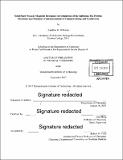Solid-state nuclear magnetic resonance investigations of the influenza M2 protein : structure and dynamics characterization of channel gating and conduction
Author(s)
Williams, Jonathan K. (Jonathan Kyle)
DownloadFull printable version (30.85Mb)
Other Contributors
Massachusetts Institute of Technology. Department of Chemistry.
Advisor
Mei Hong.
Terms of use
Metadata
Show full item recordAbstract
Solid-state nuclear magnetic resonance (ssNMR) spectroscopy is a powerful technique that can be used to probe the structure and dynamics of biomolecules that are intractable to study by other structural biology methods. In this thesis, the mechanisms of conduction and gating are investigated in the influenza AM2 and BM2 proton channels bound to native-like lipid bilayers. Using pH-dependent 15N chemical shifts of the conserved Histidine residue, we have found that the proton conduction mechanism is the same in all of the M2 channels (WT AM2, S3 IN AM2, BM2) studied, and that the conduction cycle involves proton shuttling via hydrogen-bonding with water. For the first time, unambiguous structural restraints and sidechain dynamics were measured for the gating residue Trp4l in the AM2 channel. Trp4l was found to come into close contact with His37, close enough to undergo periodic cation-[pi] interactions that ensure unidirectional proton flow. Water-edited ¹H-¹³C correlation experiments were used to investigate the channel hydration of AM2 and BM2 tetramers, and S12 in the C-terminal BM2 channel was found to have the largest pH-dependent spin-diffusion buildup of all residues studied, indicating that the BM2 serine triplet plays an important role in conduction. New ssNMR methods were developed to probe long-range ¹³C-¹³C distances, and to edit and clean-up crowded spectra of peptides and proteins containing aromatic residues. The ASSET technique removes the aliphatic cross peaks of all residues except for Phe, Trp, Tyr, and His in a two-dimensional ¹³C-¹³C correlation experiment, while a two-dimensional ¹³C-¹³C correlation experiment with gated-decoupling retains only non-protonated 3C resonances. The studies in this thesis have provided insight into the functionally important His and Trp residues in the M2 proton channel of the influenza virus, and provide new avenues for studying other peptides and proteins containing aromatic residues.
Description
Thesis: Ph. D. in Physical Chemistry, Massachusetts Institute of Technology, Department of Chemistry, 2017. Cataloged from PDF version of thesis. Includes bibliographical references.
Date issued
2017Department
Massachusetts Institute of Technology. Department of ChemistryPublisher
Massachusetts Institute of Technology
Keywords
Chemistry.